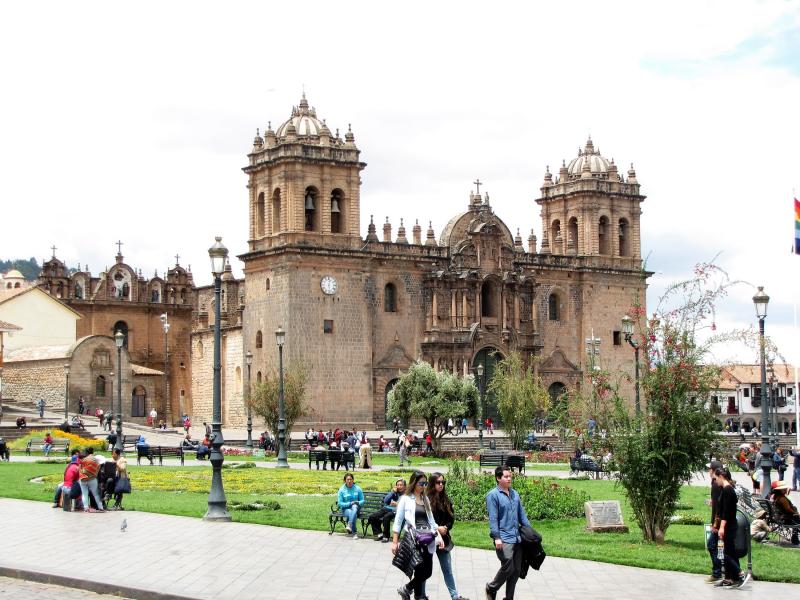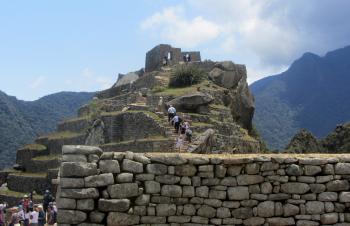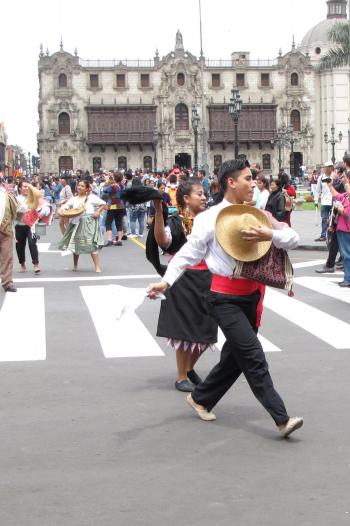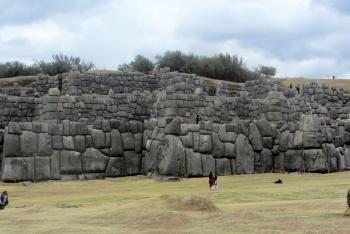Celebrating with a long-awaited trip to Peru’s Machu Picchu
This article appears on page 21 of the April 2017 issue.
My wife, Zelda, and I have been fortunate and privileged to have visited about 100 countries over the last 40 years. More than 30 years ago, I visited Peru several times as a member of the Army Chief of Staff Subject Matter Expert Exchange (SMEE) program, but my wife had never been to Peru. I have always wanted to see Machu Picchu, but after one of Zelda’s sisters experienced altitude sickness in Cuzco years ago, Peru was a no-no.
Then, last year, Zelda read about Lake Titicaca, and it sparked her interest, so she decided that perhaps we should go for our 50th wedding anniversary.
Making plans
I was approaching 79, am heavy and have had two ankle replacements, and Zelda was 76, so we checked with our doctors before planning our trip. They said there was no medical reason for us not to go.
I searched the various tour providers and selected a tour from Cosmos (Littleton, CO; 800/276-1241, cosmos.com) because of the itinerary.
We would fly directly to and from Lima and spend several days in the Sacred Valley and Machu Picchu to become acclimated before going up to Cuzco. Then the tour would take us up to Puno and Lake Titicaca and, even farther up, to the Colca Canyon.
Latam Airlines (the result of a merger between TAM and Lan) had the best flight schedule from Washington Dulles International to Lima.
I contacted our longtime, wonderful travel agent, Denise Fritz (denise@pavlustravel.com), to inquire about availability for our anniversary. The trip was available, so we booked it.
After a $1,200 promotional discount, the trip cost $8,018 for both of us, including trip insurance, gratuities, airfare to and from Lima and in-country flights. (As a side note, the same trip with Vantage Deluxe World Travel, staying at the same hotels, was priced at $2,000 more per person!)
Getting there
On Sept. 25, 2016, our flight departed Dulles at 11:30 p.m. We arrived in Lima on time, picked up our luggage and found a Cosmos representative waiting. After a drive of a little over an hour, we arrived at San Agustín Exclusive (not El Tambo II, which was on our hotel list).
Our room was very nice, with a view overlooking the street and the Miraflores district.
We linked up with our tour manager, Fernando Casariego, and learned that there was a meeting scheduled for our group at 8 p.m. When we arrived, we were surprised to find only 16 other travelers there.
The tour had begun about two weeks earlier in Rio, we were told, so our group would be joined by the other 25 tour members arriving from Argentina.
Fernando passed out information sheets and our program for the following day.
We soon came to really appreciate him. He not only kept track of everyone through the numerous crowds and bus, train and air trips, but he had all our boarding passes, seat assignments and bus and train tickets ready in advance of each leg of the tour. He was exceptional!
The next morning, we had a great buffet breakfast and left for our bus tour of the city. It happened to be World Tourism Day, and we were surprised to encounter a huge parade. It was like Macy’s Thanksgiving Day Parade or the Rose Parade! There were bands and marching units in colorful costumes from all over Peru.
Our bus tour lasted much longer than programmed to allow us to enjoy the festivities.
Heading higher
The next morning, we were up early to head to the airport for our flight to Cuzco. We had to walk from the bus park to the terminal, so Fernando arranged for porters to take our large bags, and the local guide from the day before arranged a special line for us at the Latam ticket counter.
We proceeded to the domestic gates and found the security check to be quick and easy.
After our arrival at Cuzco’s small airport, we were advised to buy snacks for lunch. Again, porters helped with the bags, which had arrived promptly.
Out in the parking lot were two buses and two local guides, and we were divided into two groups, the Llamas and the Alpacas. We became Alpacas for the next four days.
Our guide, Gonzalo Lima, was proud of his Inca lineage. His native language was Quechua, his second language was Spanish, he learned English in graduate school, and he was studying German. His wife, whom he had met in graduate school, was also a tour guide, and she spoke Italian and Portuguese as well as Spanish.
When our buses got to the airport gate to leave, we found it was closed. Teachers were striking for higher pay, and they were picketing in front of the airport. We had plenty of time to eat our airport snacks.
Once on our way, we descended into the Sacred Valley. The road was narrow, with a great many sharp curves. As we came down into the valley, there were amazing Incan terraces on both sides of the road.
One of our group members who was taking Diamox became ill and passed out, though we were not at that high an elevation, perhaps 9,000 feet. He was given oxygen, and he eventually became acclimated and was able to complete the trip. Another lady got ill that night, and as we were leaving Cuzco (11,000 feet) for Puno (13,500) several days later, she decided to go back to Lima, at sea level.
The Sacred Valley
Our first stop in the Sacred Valley was at Awana Kancha to see, and learn about the importance of, camelids, specifically llamas, alpacas, vicunas and guanacos. There were demonstrations on spinning and weaving wool plus a huge store with reasonably priced woolen products.
We drove on to Písac, stopping at an interesting Indian market, then continued past a sign pointing to Hotel Hacienda del Valle, the hotel on our schedule, driving quite a bit farther to Inkallpa Valle Sagrado, which was a more-than-adequate accommodation. Dinner that evening at the hotel was very nice.
We started drinking coca tea at every opportunity to help prevent altitude sickness, and we actually liked it. Each hotel we used had coca tea in the lobby and with the coffee makers in the rooms.
In the morning we boarded our buses for Ollantaytambo, a village with a large Incan archaeological site and the train station for departures to Machu Picchu. We had an opportunity to explore the village and visit a local home before visiting the Incan site, which was large and impressive.
We also visited the Seminario Ceramics workshop. The proprietor was a world-renowned sculptor with works on display at the Louvre and Smithsonian. His wife, also a famous sculptor, conducted part of the tour.
Machu Picchu
The next morning we packed a small bag to sustain us for several scheduled nights at Machu Picchu. The rest of our luggage was sent on to Cuzco. Back in Ollantaytambo, we boarded the Vistadome train after a walk from our bus through a very crowded, narrow street with vendors on each side. There were snack shops and bathrooms at the station.
Machu Picchu sits in the high rainforest, so it rains frequently, and the site is often shrouded in clouds and mist.
Our train car was clean and modern, with windows in the top. As we followed the river downward, we could look up to see the farming terraces on each side. Nearing Machu Picchu, all we could see were trees and rock walls as the valley became steeper.
When we arrived, we followed a serpentine route through the market to our hotel — again, not the one on our program. Our room at El MaPi was nice but small, and it had almost no storage.
As soon as we checked in, we were each given two bus tickets and two entrance passes to Machu Picchu. (The prices printed on the passes, in US dollars, made us sure that our all-inclusive trip was a bargain.)
The bus-boarding area was close to the hotel, but our seat was extremely cramped and uncomfortable. The road going up was steep, curvy and dusty. It took about 30 minutes to reach the site.
The lines were short, and we were past the entrance in minutes.
The classic picture of Machu Picchu is of the view from the Sun Gate, but it shows only a small part of the very top. It does not do it justice. Machu Picchu is huge, and only a small part has been uncovered.
Our guide said it was over an hour’s climb to the top of the next mountain, but, once up there, he said, it was worth it, as there was an Incan observatory in great condition. We took his word for it, since we did not, personally, make the climb.
Our guide lectured as we toured Machu Picchu. The complex had many areas of interest and displays explaining the Incas’ view of the universe. We spent an extremely interesting afternoon learning about the Incan culture and walking the ruins. It greatly exceeded all of our expectations.
One warning — there were llamas wandering the ruins, and anyone who got too close risked getting ticks, like I did.
The second bus and entry tickets were for those who wanted to go for an early-morning climb to view the sunrise from the Sun Gate. I had thought about getting up at 4 a.m. to walk up to the Caretaker’s Hut, about halfway up to the Sun Gate, but it poured.
A few hardy souls did go, and it quit raining just at sunrise, but others got so soaked waiting for the buses that they gave up. I couldn’t have begun to climb the slippery rocks.
Back to the city
Returning to Cuzco, we checked into our hotel, José Antonio, in the heart of the city, in the evening. After breakfast the next day, we drove high up into the hills overlooking the city. Our first visit was to Kenko, or Q´enqo (which means “zigzag”), a fascinating ruin with arches and tunnels of limestone. There were images of a condor, a llama and a puma etched into the rock as well as caves with altars in the center and images carved into the walls.
Next was a visit to Sacsayhuamán, a huge complex, even though only 20% of it remains.
In 1536 it was the site of one of the most bitter battles of the Spanish conquest. The site was littered with bodies, which attracted flocks of condors — memorialized today by the eight condors incorporated into Cuzco’s coat of arms.
A huge, towering 3-level ruin remains. One carved rock at the main gate is said to weigh more than 300 tons.
Returning to the city center, we visited La Catedral, a huge structure built with blocks taken from Sacsayhuamán. Started in 1559, it took nearly 100 years to finish. The Cathedral contains the famous Marcos Zapata painting “The Last Supper,” which features an entrée of cuy (guinea pig).
A long walk took us to the Santo Domingo Monastery/Coricancha, a monastery built beside and on top of an Incan temple and observatory. As we approached from the rear of the site, the large Incan observatory was clearly visible.
We entered the monastery courtyard, with Christian statues and paintings on three sides, but the more interesting parts, to me, were the Incan rooms and observatory.
A buffet dinner in the somewhat private upstairs room of a nice restaurant in the town square, accompanied by traditional music and dancing, was a pleasant way to end the day.
Zelda and Fritz Oelrich’s journey continues in next month’s issue.




